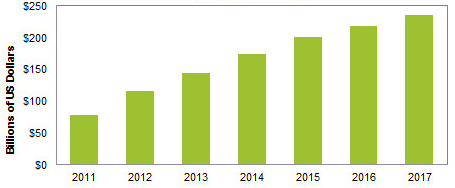Cloud-Related Spending by Businesses to Triple From 2011 to 2017 – IHS
At $145.2 billion in 2013
This is a Press Release edited by StorageNewsletter.com on February 21, 2014 at 2:53 pmAn increasing move on the part of enterprise businesses to move their information technology services, applications and infrastructure to a cloud-based architecture will cause market revenue in this segment to surge by a factor of three from 2011 to 2017, according to IHS Technology.
Global speding forecast by enterprises and cloud architectures
(in $ billion)
(Source: IHS Technology, February 2004)
Global business spending for infrastructure and services related to the cloud will reach an estimated $174.2 billion this year, up a hefty 20% from $145.2 billion in 2013.
And in a sign of the market’s vigor, spending will enjoy continued strong growth during the next few years as enterprises everywhere race to come up with their own cloud-storage solutions. By 2017, enterprise spending on the cloud will amount to a projected $235.1 billion, triple the $78.2 billion in 2011.
“With the cloud touching nearly every consumer and enterprise around the globe, spending for cloud-related storage, servers, applications and content will be dedicated toward building a framework that is rapidly scalable, highly dynamic, available on-demand and requiring minimal management,” said Jagdish Rebello, Ph.D., senior director and principal analyst for the cloud and big data, IHS. “The robust growth will come as an increasing number of large and small enterprises move more of their applications to the cloud, while also looking at data analytics to drive new insights into consumer behavior.” `
“Spending on cloud services, applications, security and data analytics will account for an ever growing portion of total information-technology expenditures undertaken by enterprises, valued today at approximately $2 trillion,” Rebello noted. “And the most engaged among spenders will be those seeking to ensure their continued relevance to consumers in the future.”
Why the cloud?
“The cloud is becoming a critical cornerstone in the strategies of those wishing to offer online storage, computing, analytics and provisioning services. This is because the vast amounts of media now being consumed on mobile devices like smartphones, tablets and computers require larger storage solutions, which now the cloud can provide. Such developments, in turn, will drive multibillion-dollar investments in cloud-based architectures,” Rebello said.
Already, small and giant companies alike are pushing to provide consumers and enterprise users with their own public or private cloud storage services. Some – like Google, Apple, Amazon and Microsoft – are offering public cloud storage to drive adoption of the individual companies’ hardware and content. Others, like Barracuda, Dropbox and Carbonite, are adopting the so-called Freemium model-in which premium storage services are available on top of a fixed amount of free storage-in order to compete with the giants.
“The fight for dominance is understandably fierce,” Rebello noted.
The number of global consumer subscriptions to the cloud will jump to 730 million this year, up from 630 million in 2013, representing a potentially vast base of users to which cloud suppliers can market their products and other non-cloud services.
Amazon, for instance, offers an inexhaustible range of products, and transforming even a casual user of the online giant’s cloud services could well bring in an endless stream of future revenue as the user becomes a loyal and permanent client.
The future power brokers yet to be determined
Among the various stakeholders involved in offering cloud infrastructure and services, wireless providers are exceptionally well-situated to offer online cloud storage in order to boost value to their customers.
“With the cloud, wireless providers can help reduce churn, a periodic problem as customers defect to other operators. Providers can also use the cloud to seek out demographic information to help them come up with tailor-made offerings for existing clientele. By using big data and sophisticated data-analytic tools, wireless providers could offer truly differentiated services to subscribers,” Rebello pointed out.
To date, however, wireless operators have lagged behind in cloud offerings, compared to other stakeholders like Google and Amazon. As a result, the operators are missing out on cloud-related revenue, which is going instead to rival factions of the mobile value chain.
A new cloud paradigm will dictate new ways to manage data. Issues of security and compliance must be addressed, and cloud services need to be able to manage content in an organized fashion. Moreover, issues of data loss, unauthorized access and mining for marketing purposes require deft handling.
All told, cloud services must strike the correct balance between providing convenience to users, while at the same time respecting their privacy, IHS believes.














 Subscribe to our free daily newsletter
Subscribe to our free daily newsletter

